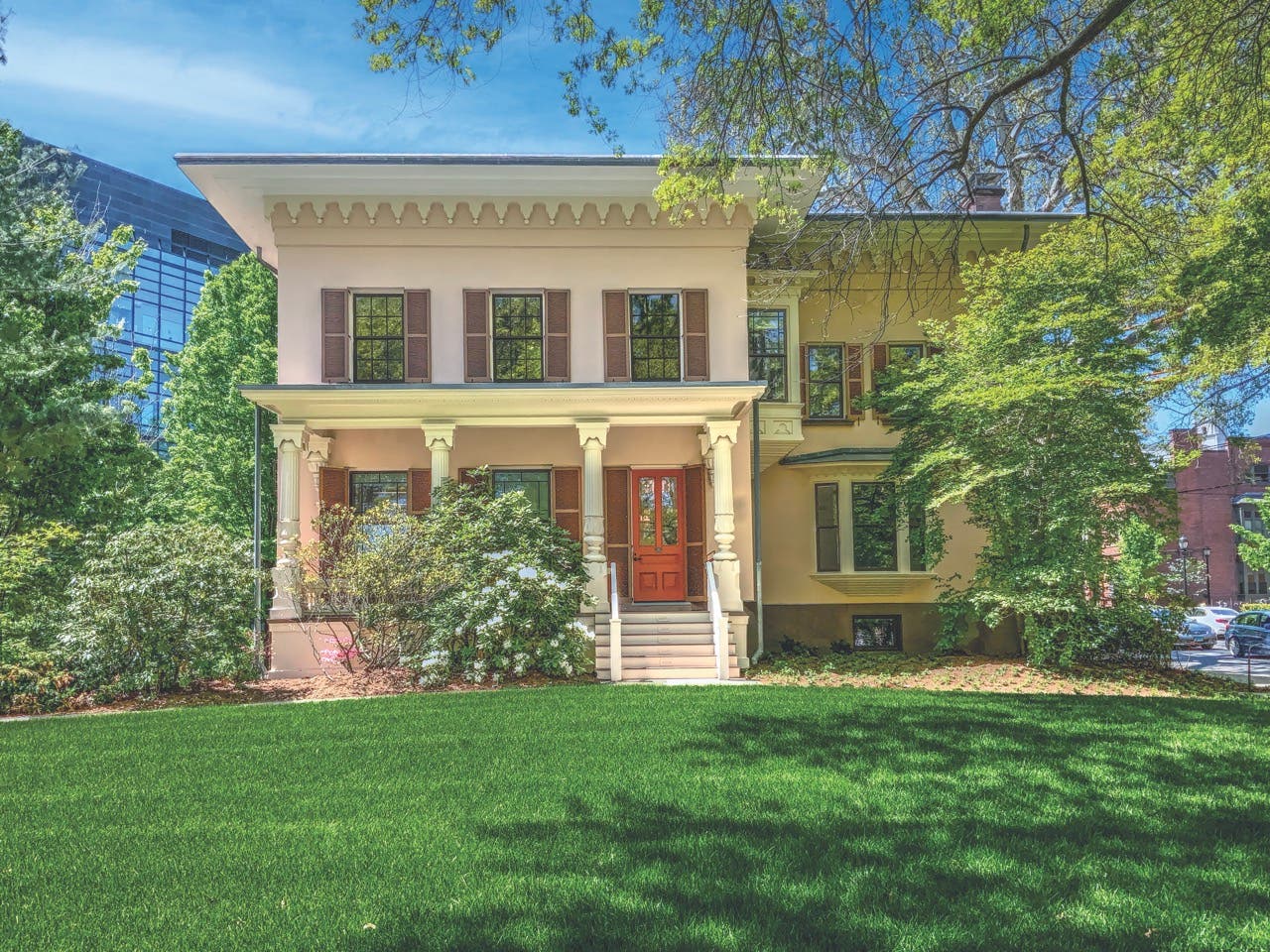
Product Reports
Maintaining Metal Fencing

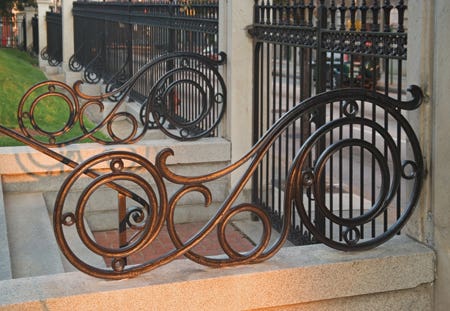
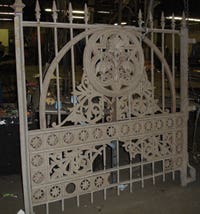
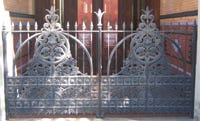
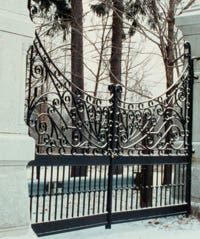
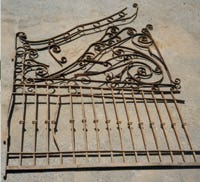
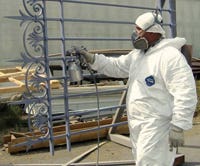
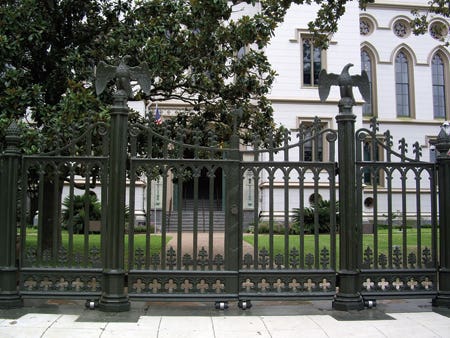
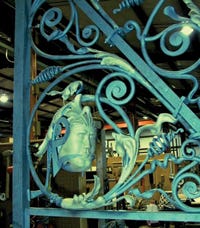
Wood may be the most expedient fencing material, but when it comes to surrounding public and non-residential buildings for decades — even centuries — the best blend of beauty, versatility and durability has always been iron and steel. Long-lived as they are, iron and steel fences and railings can't survive on their own, especially against impact damage and their unrelenting enemy, rust. Regular maintenance in the form of surface protection and proper repairs is key, as this short course helps explain.
Surface Protection
Left exposed, iron and steel are inevitably destroyed by rust, so the first line of defense for most historic ironwork is to protect it with some sort of coating. Rust — technically the oxidation of ferrous metal — is most often caused by exposure to water and air, but is also the result of salt air, sea water, acids, acid rain, and air pollutants. Oxidation in non-ferrous metals like bronze and copper produces a patina that actually protects the metal from further reaction. Rusting of iron, however, produces a porous film that holds moisture, promoting corrosion until the metal is completely eaten away.
"Oxidation is nature's attempt to take iron back to its original state," explains Scott Howell, vice president and general manager at Robinson Iron, Alexander City, AL. "Oxidation is blocked if we can separate the iron from air and water with some sort of coating." While steel fencing may be ordered factory-galvanized — that is, electro-plated or hot-dipped with a sacrificial shield of zinc — historic iron and steel fencing is typically protected by paint or similar coatings that must be carefully maintained — especially immediately after repairs or installation."
Meticulous preparation is critical if the metal is to hold a coating. First, the surface must be cleaned scrupulously free of rust, scale, oil or grease. After chipping away any loose paint or rust, many projects move to low-pressure, dry-grit blasting with particles 70-100 mesh in size at no more than 80 lbs. per square inch. Scaling hammers and needle guns are also effective tools. Wet blasting of any kind is out because it immediately rusts the iron. Where blasting is not permitted or practical, wire-brushing and sanding down to bright metal is an option for repairs and small installations.
After preparing the surface, some projects treat the metal with a rust converter, such as tannic-acid based products that chemically convert the iron oxide rust to more stable compounds. Converter or not, the bare metal must be quickly coated with primer. Traditional iron primers, which contained red lead and zinc, are now unavailable (except for some industrial uses) due to their heavy metal content. They are replaced by alkyd and acrylic rust-inhibitive primers containing iron oxide, zinc oxide and zinc phosphate pigments.
For example, Robert Baird, vice president atHistorical Arts & Casting. West Jordan, UT, says his firm has had success using a system based on a zinc-rich primer. "It's about 80 percent zinc powder that comes close to galvanizing," says Baird, "and we follow this with a high-build epoxy intermediate coat that 'locks-in' the primer."
Afterwards Historical Arts & Casting applies a polyurethane topcoat. For coatings applied in its plant, Stewart Iron Works in Covington, KY, uses a proprietary Enviro-coat system. "The primer substrate is similar to powder coating," says Sheri Bomkamp, director of design, "but the cathodic epoxy base coat is electrostatically charged under water, so that the primer seeks and covers all the minute pores and cracks in a casting using capillary action." Stewart Iron then follows this with a polyester urethane powder coating that is compatible with brush-applied urethane wet coatings, "so that the end-user can do their own maintenance in the field later," says Bomkamp.
Whatever the product, never use water-based primers, which will immediately rust the iron, or apply them in fog, mist, or on very humid days. Outside of a factory, primers are best applied by hand-brushing (or roll-and-brushing) so that the primer is worked into the pores and crevices of the metal.
In the field, most fences are finished with two coats of an appropriate (usually alkyd-based) paint product made for metal, such as the industrial maintenance coatings produced by most major paint manufacturers. Glossy sheens are not only historically appropriate, but they also tend to shed dirt and water more than matte sheens before they eventually dull down. Black is the ubiquitous, almost default color for iron fencing. However, don't overlook greens and stone colors that were also used historically and will show more shadows that bring out the ironwork's details.
Repairing Iron
When properly maintained, cast-iron fencing is remarkably strong and durable outdoors, but even this tough metal can require repairs after decades of use, neglect, and sometimes flaws in original construction or installation. Repairs begin with cleaning the fence, then inspecting it for problems. Says Baird, "Doing a class-A restoration typically means taking the fence down and stripping it to a SSP standard — basically bare white metal."
Howell agrees. "When cast iron has a lot of paint build-up, it conceals many of the decorative details, such as incising or leaf patterns," he says. "Paint removal may also reveal more work, such as missing fasteners — typically wrought-iron bolts or pins." Adds Bomkamp, "Paint may also be hiding cracks in cast iron — in fact, the paint may actually be holding the pieces together!"
Though strong in compression, cast iron is brittle, and historic fencing and posts are commonly victims of impact damage, as well as broken connections and missing components. Cast-iron components are also frequently hollow, which means cracks can allow water intrusion, leading to rust or freeze-thaw damage. Plus, many a cast iron fence is the victim of inappropriate repairs. A common example is the hollow newel post or railing that has split after being filled with concrete — a porous material that absorbs water that rusts the thin castings or blows them apart when it freezes.
Cast-iron cracks that are small and non-structural can often be stabilized with pins, epoxy steel, or even polyester auto body repair materials. Bigger breaks, however, are not so simple to repair. "Welding or brazing cast iron to cast iron is tricky and not always possible," explains Bomkamp, "because the metal has to be heated to beet red and sometimes the casting is too thin to do this."
She notes that welding cast iron to other ferrous metals such as steel is more reliable. However, with the right conditions and equipment, such as special nickel-alloy welding rods, a skilled welder can sometimes mend broken cast iron parts — but only for cosmetic purposes. Structural members, such as posts, must be reinforced with steel or replaced altogether.
More problematic is replacing missing parts. While wrought-iron components can usually be individually reproduced in mild steel by qualified artisans, casting iron components is a more complicated process. Foundries that specialize in historic fencing sometimes can provide replacements for common patterns or components, such as finials.
For example, Stewart Iron, which has been in business since 1862, has a large collection of molds. "So when people are looking to replace a historic part," says Bomkamp, "we may have a match — in fact, we may have made the original part in the first place. If not, we have all the facilities to re-create the pattern."
Barring the availability of an appropriate existing mold, casting replacements requires making a new sand mold from a new pattern — a whole other order of project. Since newly cast iron shrinks approximately 1/8-in. per foot as it cools, using an existing piece of ironwork as a pattern produces a slightly smaller component. In some projects, this shrinkage is not critical, but if an exact match is necessary, then a new, oversize pattern has to be made.
According to Howell, one technique Robinson Iron used in the past to account for shrinkage was to take original elements, build them up with polyester resin then make new sand molds from these new oversize patterns. "Today, however, we can laser-scan the original and cut a new pattern in polyurethane," says Howell, "a process that does not even require removing the part from the fence."
Replacements cast from aluminum do not have the shrinkage problem but, upon installation, the aluminum and cast iron have to be isolated or galvanic action will occur. Stainless-steel fasteners and pins are recommended for re-attaching old or new cast-iron work.
Wrought-iron components can still be joined with traditional methods, such as riveting (with countersunk heads, unless rivets are part of the design), collaring (where hot iron strips are bent around abutting members), and hammer-welding (where members are forge melded without the flux used in oxy-acetylene or electric-arc welding). Robinson recommends the use of Type 304 stainless-steel bolts to reassemble restored fencing.
However, mild steel often cannot perform like traditional wrought iron. Explains Bomkamp, "True wrought iron is composed of carbon molecules that align in long fibers somewhat like wood grain, which allow it to be worked repeatedly to make forms like scrolls and leaves." By comparison, she says wrought or mild steel, today's substitute, is composed of lots of random individual molecules that can be similarly worked up to a point. "This makes it act kind of like a paper clip; after you bend it a few times, it breaks."
Anchoring
Many iron fences start to suffer not from deterioration of the fence itself but from failure of the anchoring, typically into some sort of masonry. Where the fence or railing is anchored in stone — customary for exterior stairs and urban fences — the fence post or newel stanchion is traditionally "lead-set" — that is, placed in an oversize hole and filled with molten lead.
Howell says that, given the ever increasing concerns over environmental lead, Robinson Iron prefers instead to anchor with epoxy adhesives, such as the products made by Hilti anchoring systems. Either way, post and stanchion ends should be rust-proofed, and once set, the filler should be detailed to shed water, not collect it in the hole. Any moisture that finds its way into the buried iron — especially if the anchor hole creates a little reservoir -- will cause rust jacking that can spall or split the stone.
Many a cast-iron newel post is anchored by a central threaded rod that is okay where it enters the stone, but leaves the newel wobbly nonetheless. In these cases, tightening the nut or finial at the top, usually with gentle applications of penetrating oil, wire brushing, and a little heat from a torch, will often pull the newel back into place.
In contrast to wood fence posts that can be set directly in soil, freestanding iron fence posts must be set in concrete footings that extend below the frost line in order to withstand winter heaving. As Baird notes, "The key to ironwork maintenance is eliminating the conditions that caused the problems in the first place."
Gordon Bock, writer, architectural historian, technical consultant, and co-author of The Vintage House (www.vintagehousebook.com), lists his fall workshops and seminars atwww.gordonbock.com.
Gordon H. Bock is an architectural historian, instructor with the National Preservation Institute, and speaker through www.gordonbock.com.



